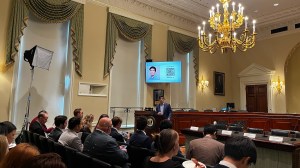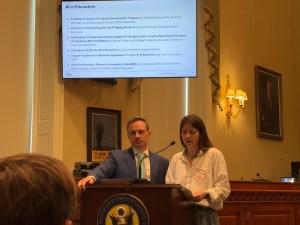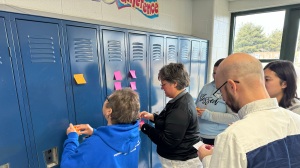Crowdsourcing AI Expertise

Earlier in the spring of 2024 I had the opportunity to become a member an artificial intelligence (AI) legislative policy sprint with the Federation of American Scientists (FAS). It literally was a sprint as we created all the briefs in about eight weeks. This crowdsourcing of expertise by FAS, as it was described by Daniel Correa, CEO of FAS, was an incredible undertaking on their part. This was truly a bipartisan labor of collaboration bringing together those with experience using AI to create the top ideas for legislation and policy related to AI.
At the time that the FAS put out the call for proposals for the policy sprint I was taking a course in AI in the Saïd Business School at the University of Oxford. I was learning so much and was realizing how far we were behind in the United States in education in terms of utilizing AI for considering the all important questions of how and what students learn. In a project for my Oxford course I wrote:
“First, teaching about artificial intelligence (AI) and teaching with AI are two very different things. In education we are going to have to do both; facilitating learning about the ethical use of AI and using AI in real world/work-based learning, so students understand how to use AI in careers. Therefore, one of the main obstacles that education faces is the need for education to evolve in the face of so many new technological developments making use of AI. Our policies will need to reflect the capabilities AI affords us. Educators must be trained in AI in programs very much like this one I am in now. Skill acquisition will need to be paramount to student seat time. Practicing, memorization, and repetition in many subjects is becoming irrelevant due to AI. AI allows us to shift memorization to understanding. Many are predicting this change in education to take two to six years. In education I believe societal acceptance is the biggest factor determining obstacles and adoption. Many might consider AI a technical challenge, which I recognize there are questions of technological progress, but I believe regulation (and who owns that regulation), economic conditions, plus the societal factor make this, instead, an adaptive challenge.”
Yesterday it was fascinating to listen to my colleagues’ ideas and views on AI in other sectors, including healthcare. One theme that came out throughout the day was that no matter the sector we need proactive prescriptions, not random knee-jerk reactions. This includes being responsive to new sources of risk. In other words, we need to catch threats before they happen. We also need to identify threats before they become public.

In my sector of education the themes of there not being enough data and the lack of training or guidance for teachers to be successful using and facilitating student use of AI emerged. One thing we need to do is leverage and mine the data we have. One thing is clear; we must be vigilant in helping educators understand AI and how to teach about AI as well as using AI to facilitate learning. I loved Zarek Drozda‘s comment when he said, “Education is a vaccine misinformation.” We must not miss the opportunity to educate our children for dealing with and using AI.
Click on A National Center for AI in Education to read my proposal. You can also click on New Legislative Proposals to Deploy Artificial Intelligence Strategically to see all the FAS Policy Sprint proposals.
Those proposals are broken into four categories:
- AI Innovation, Research and Development, and Entrepreneurship
- AI Trust, Safety, and Privacy
- AI in Education
- AI in Healthcare
I applaud the Federation of American Scientists for doing this innovative crowdsourcing of expertise to bring together great minds for creating policy ideas related to artificial intelligence. It was such an honor to be on the journey with everyone.
Leading Like आशा Āśā

I read a statistic this morning that over 80% of New Year’s resolutions fail by mid-February. Since we are in the last week of February, I would like to ask: have you made a New Year’s resolution and, if so, has it failed? I don’t make New Year’s resolutions so I am in the clear on this one. My reason for not making them is that they are frustrating and not sustainable.

I just finished the great book Slow Time Between the Stars by John Scalzi and I’ve already written a couple of posts inspired by that book. Here is another. At least seven times during the book, the only character in the book, an AI being, आशा Āśā, referred to “repairing and improving” itself. आशा Āśā once said, “…what I was doing now, repairing and improving itself for a further journey” (Scalzi, p. 22). At one point आशा Āśā even referred to taking 200 years for repair and improvement. This really got me to thinking about the time we spend, don’t spend, or should spend, on repair and improvement for ourselves. Part of the reason New Year’s resolutions don’t work is because they are focused on fixing something we see as being inadequate. If we are honest, it is usually something pretty superficial.
I realize that आशा Āśā is a fictional AI character, but maybe we can learn from its approaching improvement from a continual and long game approach. Incidentally, in the book आशा Āśā is a Sanskrit word with the approximate meaning of “Hope.” The character, आशा Āśā recognizes being changed by knowledge in the book.
As a person who believes in building on our strengths, I try not to focus so much on the weaknesses, except in the areas I want to learn and grow in. For example, I am taking a University of Oxford Artificial Intelligence class right now. To better serve my clients I need to know how to better leverage the use of AI, understand how AI works, and have a better knowledge of the policy and regulatory implications surrounding AI. AI is not necessarily a strength area, but one I need to allow time for growth and improvement in.
Focusing on our strengths can help us build upon what we are already good at and continuously improve. By leveraging our strengths, we can achieve greater success and continue toward reaching our full potential. Again, we can recognize our weaknesses and work toward improving needed areas, but emphasizing our strengths can lead to more efficient growth and development.
Setting Our Consciousness To Engage

This past week I started another Oxford University, Saïd Business School course in artificial intelligence so I have really been contemplating how far we have come since John McCarthy coined the phrase “artificial intelligence” in 1956. It just so happens I am reading The Far Reaches Collection right now and am specifically reading Slow Time Between the Stars by John Scalzi presently. This is a must read told from the perspective of an artificial intelligence being on an exploration of the stars of the farthest horizons of human potential. The AI being also contemplates its own purpose. Reading this book at the same time as starting a course in AI has been interesting to say the least. It has made me contemplate what really is possible and what is there yet to experience in my lifetime.

Named आशा Āśā, meaning “Hope,” the AI being described itself as “me” saying, “I am me. The systems and processes that comprise what I am are we. The systems and processes I contribute to are us. I contain multitudes. So many pronouns, all relevant, depending on perspective.” More on this in another blog post. आशा Āśā was describing levels of consciousness that we have as humans versus its levels. For example, we can’t become conscious of the workings of our liver – it just works. आशा Āśā could decide all its levels of consciousness. It said, “So many of my functions happen at a level below where I have set my consciousness to engage.” This got me thinking about us, as leaders, and where we set our levels of consciousness to engage with the people we serve and projects we lead.
It is very important for leaders to consider where to set our levels of engagement with both the people we serve and the projects involved. By being mindful of how and where we direct our energy and focus, leaders can ensure that we are making the most impact and effectively achieving our goals. Prioritizing tasks, goals, and relationships that align with our values and long-term objectives will lead to more purposeful and effective leadership.
Finally, a leader should learn and reflect on the importance of being mindful and intentional about where we are directing our focus and energy. By asking ourselves where we have set their consciousness to engage, we can assess whether we are prioritizing the right tasks, goals, and relationships. आशा Āśā’s ability to set its levels of consciousness to engage prompts us, as leaders, to consider if we are aligning our actions with our values and long-term objectives, ultimately leading to more purposeful and effective leadership.
The Frictionless Experience

I was reading an article, “What Smart Companies Know About Integrating AI: Talent and Data are Just As Important as Technology,”this week in Harvard Business Review last night related to artificial intelligence (AI). It was interesting to contemplate the idea of a “frictionless experience.” Having a frictionless experience means having a smooth and seamless interaction or process without any obstacles or difficulties. This is the customer experience (CX) at its best. We as consumers expect the same level of service, understanding of our needs, and prompt resolution of our issues across all channels. If we are to take a customer-centric approach we need to be able to personalize at every touch point. I really believe this is also true when working with our students and families in our schools. This relates to all the various aspects, such as customer/student services, user interface design, or even personal experiences. It means that everything flows effortlessly and efficiently, making it easy and enjoyable for every person involved.
AI can also analyze user data to personalize interactions and tailor recommendations, making the experience more relevant and personalized. Additionally, AI can automate repetitive tasks and streamline processes, saving time and reducing the chance of errors. One of the big points of the article was that AI does not replace people, but better informs the people who will be doing the inventing, creating, and innovating. It is about the talent using the data.
I also think about how AI-powered chatbots could be used to tutor and help students. Chatbots can provide personalized learning experiences by assessing the student’s needs and adapting the content accordingly. Not to mention the big support to students, this could be of huge help to teachers by providing both a time-savings and important data. The Chatbots could answer questions, provide explanations, and offer additional resources to support the student’s learning journey. Notice I am suggesting giving additional support – not replacing teachers or existing support. Those same Chatbots can also track the student’s progress, provide feedback, and suggest areas for improvement. With their availability 24/7, chatbots can provide continuous support and enhance the learning experience for students. Wouldn’t it then be amazing to get that report of what questions were being asked and what I, as the teacher, needed to go back and provide more learning on. This could be incredible for a frictionless student experience.
leave a comment